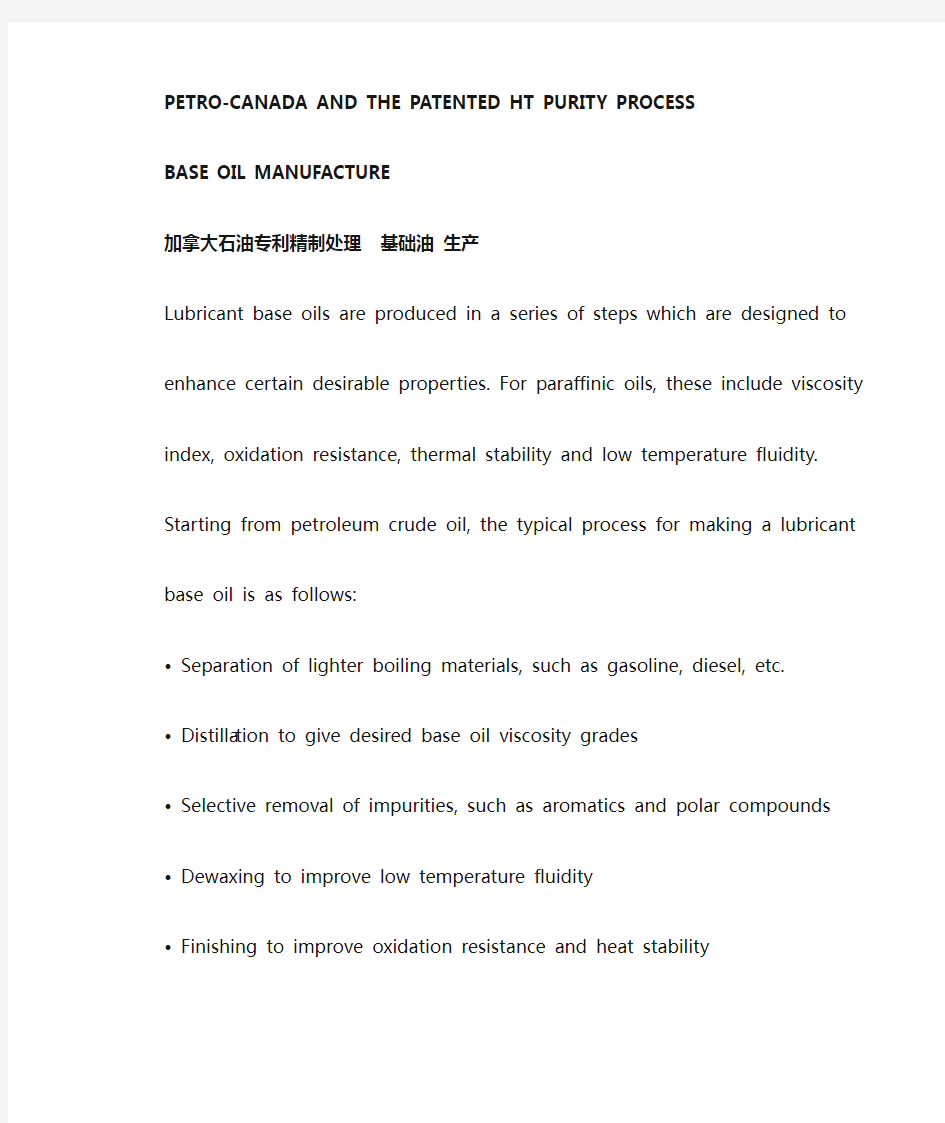基础油生产工艺详解-加拿大石油

- 1、下载文档前请自行甄别文档内容的完整性,平台不提供额外的编辑、内容补充、找答案等附加服务。
- 2、"仅部分预览"的文档,不可在线预览部分如存在完整性等问题,可反馈申请退款(可完整预览的文档不适用该条件!)。
- 3、如文档侵犯您的权益,请联系客服反馈,我们会尽快为您处理(人工客服工作时间:9:00-18:30)。
PETRO-CANADA AND THE PATENTED HT PURITY PROCESS
BASE OIL MANUFACTURE
加拿大石油专利精制处理基础油生产
Lubricant base oils are produced in a series of steps which are designed to
enhance certain desirable properties. For paraffinic oils, these include viscosity
index, oxidation resistance, thermal stability and low temperature fluidity.
Starting from petroleum crude oil, the typical process for making a lubricant
base oil is as follows:
• Separation of lighter boiling materials, such as gasoline, diesel, etc.
• Distilla tion to give desired base oil viscosity grades
• Selective removal of impurities, such as aromatics and polar compounds
• Dewaxing to improve low temperature fluidity
• Finishing to improve oxidation resistance and heat stability
Generally both Solvent Refined and Hydrocracked base oils are manufactured
this way, but differ in the processes used.
润滑油基础油是经过一系列旨在提高某些特性的步骤后生产出来的。对石蜡基基础油来说,这些特性包括粘度指数,抗氧化性,热稳定性和低温流动性。从原油开始,生产基润滑油基础油典型过程在以下几步:。轻沸点材料的分离,比如汽油,柴油等被分离出来;
。蒸馏得到所需要的基础油粘度等级;
。选择性去除杂质,比如:芳烃和极性化合物;
。脱蜡以提高低温流动性;
。最后提高抗氧性和热稳定性;
通常溶剂精制和加氢裂化基础油的生产路径都是这样的,区别只是使用处理方法的不同。
BASE OIL CLASSIFICATION基础油的分类
Before reviewing how base oil is manufactured, we should explain the
American Petroleum Institute‟s (API) Base Oil Classification system. For
engine oils, the API system classifies base oils into five major groups, as
shown below:
上面回顾了基础油的生产过程,我们接下来说明API的基础油分类系统。针对发动机油,API分类系统中有五个主要的级别:
Group I, or conventional base oils manufactured by Solvent Refining, make up
most of the base oil produced in the world today. Containing more than
0.03 wt % Sulphur and less than 90 wt % Saturates, they are less pure than
Hydroprocessed or Synthetic base oils. While these groups were originally
intended to be used for engine oils, their usage has expanded beyond this
area.
Group II and III base oils are manufactured by what the API calls Hydroprocessing
or Severe Hydroprocessing. These are just other names for
Petro-Canada‟s Patented HT Purity Process. With Sulphur contents of less
than 0.03 wt % and Saturates
一类基础油或用溶剂精制生产的基础油,是今天世界上主要的基础油产品。包括含硫量超过3%和饱合烃含量小于90%,他们的纯度低于加氢或是合成油。尽管这一组最初是设计用于发动机油,但现在他们的使用拓展超过这一区域。
二类油和三类油是用API称之为加氢处理或是重加氢处理方法制造。硫含量低于0.03%饱合烃含量大于等于90%
SOLVENT REFINING PROCESS 溶剂精制处理
Initially, light oils such as gasoline, diesel, etc., are separated from crude
petroleum by atmospheric distillation. The resulting material is charged to a
vacuum distillation tower, where lubricant fractions of specific viscosity ranges
are taken off. These fractions are then treated individually in a solvent
extraction tower. A solvent such as furfural is mixed with them and extracts
about 70-85% of the aromatic material present. The solvent extracted lube
fraction is then dewaxed by chilling to a low temperature, which removes much
of the wax. This improves the low temperature fluidity of the product. Finally,
the dewaxed lube fractions are sometimes finished to improve their colour and
stability, depending on the application requirements. One common method of
finishing is mild hydrofinishing. This step should not be confused with
Petro-C anada‟s Patented HT Purity Process, as conditions of temperature and pressure in hydrofinishing are mild and less effective. The API classifies the products of Solvent Refining as Group I base oils.
最开始,轻油如汽油,柴油等,被从原油中通过汽提分离出来,其余材料被装入真空蒸馏塔。在这里润滑油馏分被按照指定的粘度范围分开。这些馏分再在一个溶剂抽提塔中进行专门的处理。用糠醛等溶剂和它们混合后去除其中75-85%的芳烃。溶剂精制后润滑油馏分进行低温冷落脱腊,以脱去大部分的石蜡。这可以提高产品的低温流动性。最后,依照应用的要求,脱腊润滑油的馏分有时要修整提高他们的色度和稳定性。修整的常见方法是轻度(补充)加氢精制。这一步与加拿大石油专用HT精制过程不会混淆的。因为在加氢精制中的温度和压力条件都是轻微和作用不大的。API溶剂精制的产品等级做为一类基础油。
PETRO-CANADA’S HT SEVERE HYDROCRACKING PROCESS加拿大石油深度加氢裂解工艺
